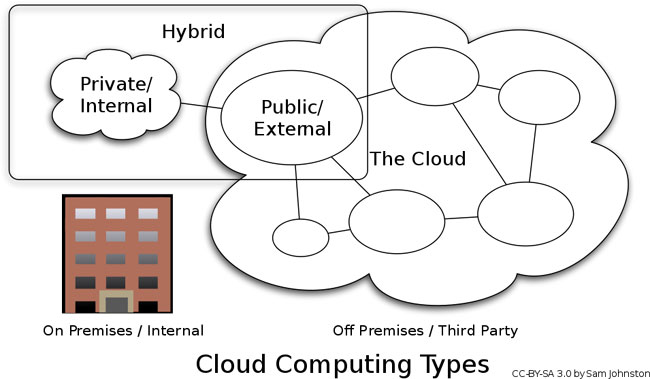|
Like us? Like us! |
| Tweet |
1.5c |
Cloud computing (or “the cloud”) is a model for enabling ubiquitous, convenient, on-demand network access to a shared pool of configurable computing resources (e.g., networks, servers, storage, applications, and services) that can be dynamically provisioned on a fine-grained, self-service basis over the Internet, via web services, internally or from an off-site third-party provider. The compute resource can be rapidly provisioned and released with minimal management effort or service provider interaction.
A cloud computing system can be classified in several ways, e.g. as a deployment model: Private, Public, and Hybrid cloud.

Private cloud -- The cloud infrastructure is provisioned for exclusive use by a single organization (which can consist of multiple business units). The computing infrastructure is dedicated to a particular organization and not shared with other organizations. Cloud computing on private networks and allows a consistent level of security, privacy, and governance control to be maintained across the infrastructure. It may be managed by the organization or by a third party and may exist on-premise or hosted externally.
Public cloud -- The cloud infrastructure is made available to the general public or a large industry group. The public cloud infrastructure allows multi-tenancy or the ability to host multiple organizations in the same general infrastructure. Access to compute resources is available via the Internet. It is managed by a third party and is hosted on the premises of the cloud provider, external to each of the tenant organizations.
Hybrid cloud -- The cloud infrastructure is composed of two or more clouds that remain as unique entities but are bound together by standard or proprietary technologies that enables data and application portability (e.g., cloud bursting for load balancing between clouds).
A fourth deployment model, community cloud is a compute infrastructure shared by several organizations and supports a specific community that has shared concerns. It may be managed by the organizations or a third party and may exist on premise or off premise.
References:
- http://info.apps.gov/content/what-cloud
- http://www.nist.gov/itl/cloud/index.cfm
- http://onekobo.com/Cloud/TagCloud.html
- http://en.wikipedia.org/wiki/File:Cloud_computing_types.svg
- http://bizcloudnetwork.com/defining-cloud-deployment-models
- http://csrc.nist.gov/publications/nistpubs/800-145/SP800-145.pdf
- http://blog.mwpreston.net/vcp-5/vcp-objective-1-5-identify-vsphere-architecture-and-solutions/
1.5c |